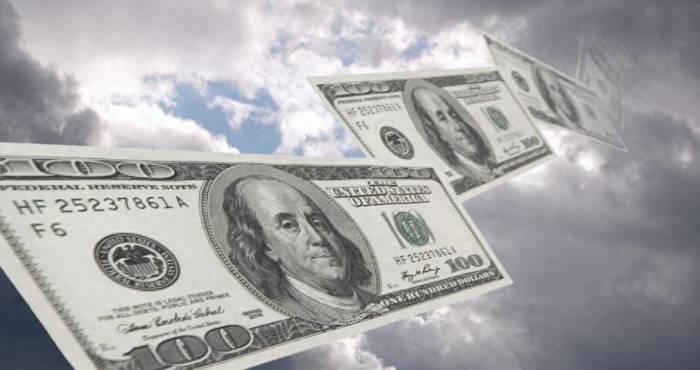Categories
News
Date
2024-09-01
RMB Surges 2100 Points, Capital May Flee US
Early this morning, the offshore exchange rate of the Chinese yuan against the US dollar reached a peak of 6.7057, breaking through the 6.7 integer threshold, just one step away.
Entering 2023, in just a short span of 10 trading days, the offshore exchange rate of the Chinese yuan has already risen by 2132 points.
The major counteroffensive has already begun!
American financial media have started to worry that in 2023, a large amount of capital may withdraw from the US market, and the US financial market may face a triple kill in stocks, bonds, and foreign exchange.
01, US Dollar Index
The US Dollar Index had already begun to rise in the second half of 2021, when the US monetary policy had not yet shifted towards contraction. It was simply because the inflation in the US was getting higher and higher, and the market began to anticipate that the US would enter an interest rate hiking cycle, hence the US Dollar Index also started to rise in advance.
Throughout the second half of 2021, the US Dollar Index rose from below 90 to 95.
Subsequently, entering 2022, the Federal Reserve began to reduce bond purchases and started to raise interest rates and shrink the balance sheet. The rise of the US Dollar Index immediately accelerated, and in just half a year, it rose to a maximum of 114.79.
Advertisement
However, an exchange rate without economic foundation is always a castle in the air. Although the Federal Reserve continues to raise interest rates, the cumulative increase of 125 points in November and December has not helped the US Dollar Index at all, but has instead started to turn downward.
Now it seems that the decline of the US Dollar Index is irreversible.02, Resisting the Dollar Harvest
As the United States continuously raises interest rates, some countries implement capital controls to prevent capital outflows. There are also countries that follow the Federal Reserve's rate hikes, even increasing rates by a larger margin, to avoid interest rate differentials with the U.S. and reduce the depreciation of their own currencies, all in an effort to prevent capital outflows.
The dollar's "mowing" behavior has made more countries realize the dangers of financial liberalization that is not yet mature. However, when currencies appreciate or depreciate, investors from various countries often exchange bonds or assets denominated in depreciating currencies for assets priced in appreciating currencies to achieve the purpose of preserving and increasing value, further intensifying the flow of funds back to the United States.
In this situation, the U.S. has indeed reaped a significant amount of inflow funds. The U.S.'s "mowing" behavior has sounded the alarm for many countries, prompting numerous nations to accelerate the "de-dollarization" process. The most typical example is the continuous selling of U.S. Treasury bonds by central banks throughout 2022. It now appears that this trend will continue in 2023, with the low status of U.S. Treasury bonds temporarily difficult to change.
In the Middle East, there is also a major revelation: the renminbi has quietly broken the petrodollar system. In the future, more and more countries will begin to try to settle oil without using dollars, and a new settlement market system is gradually taking shape.
An increasing number of countries and regions are eager to break free from the hegemonic constraints of using the dollar as the sole main trade currency.03, Great Counteroffensive
In such an international context, the great counteroffensive initiated by the Chinese yuan has been able to pass through five major challenges and defeat six generals more smoothly.
The US Dollar Index continues to decline, with the lowest point now breaking below 102, reaching 101.9783, which is equivalent to the level of early last June.
This morning, the Chinese yuan also experienced a significant increase, rising by 184 points by the close. Most notably, the high point during the trading session reached 6.7057. It is almost certain that next week, the exchange rate of the Chinese yuan will return to the 6.6 range.
In early May of last year, during the depreciation of the Chinese yuan, it first broke below 6.7. This means that this round of appreciation of the Chinese yuan has recouped the depreciation of the past half year.

04, Capital Fleeing the United States
During the past depreciation of the Chinese yuan, there was widespread concern that China would experience an outflow of foreign capital, but the facts have proven that this has not occurred.
Now that the Chinese yuan is starting to rise, we can fully anticipate a significant inflow of capital into the Chinese market.
Even American financial media believes that the United States will face a large-scale capital exodus for a simple reason: previously, funds bought dollars to bet on the appreciation of the dollar, and now that the dollar has begun to depreciate, all funds that bet on the appreciation of the dollar will make the opposite decision.
What's worse, the decline in US stocks and bonds may continue, and the US real estate market, which has been rising for most of last year, may experience a housing price crash this year.When funds flow out of the stock market, bond market, and real estate market simultaneously, it is entirely predictable that the total scale of outflows will far exceed last year's inflows.
The capital outflows that emerging markets were concerned about last year will be played out in the U.S. market this year.